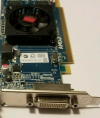britechguy
Well-Known Member
- Reaction score
- 4,747
- Location
- Staunton, VA
I have just hit upon a "first time this happened" experience in that someone dropped off a desktop gaming machine where the video outputs are only DVI or HDMI. I have never encountered a machine that has no VGA output, though it's not surprising to me that HDMI is becoming the "go to" universal output.
In my experience DVI has never been commonly used. There was a period where I saw a bit more DVI, and mostly on the monitor side of the equation than on the computer side. It seems to me that DVI never really took off.
The monitors I have kept have VGA and DVI (and one has what looks like S-Video) inputs, but none have HDMI, because they're both around 10 years old and neither has been in regular use for a while. I do almost everything on a laptop by choice.
I am just curious as to whether:
1. DVI was far more commonly used than I may think it was, since I seldom get carry in desktops and a majority of my clientele is residential?
2. Are new monitors tilting heavily toward HDMI input?
3. Have you seen many machines with DVI/HDMI output only?
In my experience DVI has never been commonly used. There was a period where I saw a bit more DVI, and mostly on the monitor side of the equation than on the computer side. It seems to me that DVI never really took off.
The monitors I have kept have VGA and DVI (and one has what looks like S-Video) inputs, but none have HDMI, because they're both around 10 years old and neither has been in regular use for a while. I do almost everything on a laptop by choice.
I am just curious as to whether:
1. DVI was far more commonly used than I may think it was, since I seldom get carry in desktops and a majority of my clientele is residential?
2. Are new monitors tilting heavily toward HDMI input?
3. Have you seen many machines with DVI/HDMI output only?

